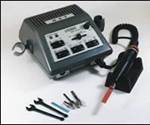Is It Still Time to Reach for a Die Profiler?
Pointers for bringing a polished surface to a high mirror finish. You have finished machining your mold core and cavity and removed them from your CNC machine. The mold components are machined in tough H-13 steel and contain several deep grooves and slots that must be properly polished to allow the molded part to eject. What is the best method for bringing the polished surface to a high mirror finish?
The technique of choice for many years was using a reciprocating die profiler. Today confusion in the marketplace has left many moldmakers with the impression that such machines are no longer available or desired. This is not the case!
The original reciprocating filing machine was developed in Sweden in 1950. Other manufacturers developed similar tools later. Updated throughout its existence, it continues to be one of the most popular polishing tools.
It is particularly favored for its effectiveness and productivity with the hardest of materials while retaining the characteristic sensitivity needed for precision handwork. Although some manufacturers have discontinued similar tools, these original classic die profilers are still sought after by many moldmakers, toolmakers and die-sinkers.
The die profiler replaces the age-old process of hand filing or draw filing in the direction of the molded part drawing or ejecting out of the mold. Hand filing has traditionally been the bottleneck in completing a mold or die. The die profile machine can file up to 120 strokes per second, a speed no toolmaker can match.
Today hand filing has become even slower as mold steels have become tougher. Also, the die profile machines have the flexibility to hold the file rigid in a fixed reciprocating position or allow it to float to follow the mold contour.
What to Look for in Your Die Profiler
Classic die profiler units have 6mm (.234) length stroke and adjustable speed of 0-120 strokes per second. For better comfort, you should use a model fitted with an ergonomic rubber grip.
One that accepts 3.5mm (1/8”) diameter shank tools and is driven by a key type shaft.1 A heavy-duty2 unit should have a larger redesigned reciprocating area with a guiding surface more than tripled in area. This unit should accept 6.4mm (1/4”) diameter shank tool and be driven by a long-lasting, more positive square-drive cable.
To be complete, a die profiler requires a drive motor. A popular choice is a reversible 1/6-hp, 18,000-rpm flexible shaft machine. This machine is 66 percent more powerful than previous motors and warranted for two years.
All drive motors should come equipped with a high-impact, plastic enclosed electronic speed control as the die profiler must not exceed 10,000 rpm and is recommended to operate at 5,000 to 7,000 rpm for longest life.
References
1FPC/R (considered the standard model).
2 FPH/R..
Related Content
-
Qualified Tool Steel Enhances Thermal Transfer, Long Tool Life
Next Chapter Manufacturing has successfully qualified HTC-45 tool steel, an optimized version of H13, to support better thermal transfer and faster cycle times for molders and die-casters.
-
How to Select the Right Tool Steel for Mold Cavities
With cavity steel or alloy selection, there are many variables that can dictate the best option for moldmaking.
-
Project Reveals Added Benefits of New P20 Grade Steel in Machinability, Cycle Time and No Stress Relief
MoldMaking Technology's Christina Fuges talks with General Motors' Shane Appel about a project testing a new P20 steel grade's dimensional stability.














